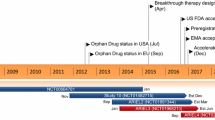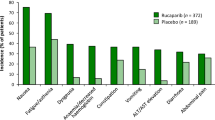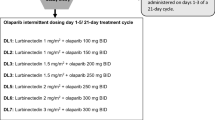Abstract
Olaparib (Lynparza™) is an oral, small molecule, poly (ADP-ribose) polymerase inhibitor being developed by AstraZeneca for the treatment of solid tumours. The primary indication that olaparib is being developed for is BRCA mutation-positive ovarian cancer. A capsule formulation of the drug has received approval for use in this setting in the EU and USA, and a tablet formulation is in global phase III trials (including in the USA, EU, Australia, Brazil, Canada, China, Israel, Japan, Russia and South Korea). In addition, phase III trials in breast, gastric and pancreatic cancer are underway/planned, and phase I/II investigation is being conducted in other malignancies, including prostate cancer, non-small cell lung cancer, Ewing’s sarcoma and advanced cancer. This article summarizes the milestones in the development of olaparib leading to this first approval for ovarian cancer.
Similar content being viewed by others
References
Girolimetti G, Perrone AM, Santini D, et al. BRCA-associated ovarian cancer: from molecular genetics to risk management. Biomed Res Int. 2014;2014:787143.
National Cancer Institute. BRCA1 and BRCA2: cancer risk and genetic testing. 2014. http://www.cancer.gov/cancertopics/factsheet/Risk/BRCA. Accessed 24 Nov 2014.
Javle M, Curtin NJ. The role of PARP in DNA repair and its therapeutic exploitation. Br J Cancer. 2011;105(8):1114–22.
AstraZeneca AB. Lynparza 50 mg hard capsules: EU summary of product characteristics. 2014. http://www.ema.europa.eu/ema. Accessed 12 Jan 2015.
AstraZeneca Pharmaceuticals LP. Lynparza™ (olaparib) capsules, for oral use: US prescribing information. 2014. http://www.accessdata.fda.gov/scripts/cder/drugsatfda/index.cfm. Accessed 5 Jan 2015.
European Medicines Agency. Summary of the risk management plan (RMP) for Lynparza (olaparib). http://www.ema.europa.eu/ema. Accessed 12 Jan 2015.
AstraZeneca. Acquisition of KuDOS Pharmaceuticals will enhance AstraZeneca’s ability to generate novel cancer treatments [media release]. 23 December 2005. http://www.Media/Press-releases/Article/20051223--Acquisition-Of-KuDOS-Pharmaceuticals-Will-Enhance-Ast.
Fong PC, Boss DS, Yap TA, et al. Inhibition of poly(ADP-ribose) polymerase in tumors from BRCA mutation carriers. N Engl J Med. 2009;361(2):123–34.
Bundred N, Gardovskis J, Jaskiewicz J, et al. Evaluation of the pharmacodynamics and pharmacokinetics of the PARP inhibitor olaparib: a phase I multicentre trial in patients scheduled for elective breast cancer surgery. Invest New Drugs. 2013;31(4):949–58.
Dedes KJ, Wilkerson P, Wetterskog D, et al. PARP-inhibitor olaparib in the treatment of ovarian clear cell cancer: predictors of sensitivity and resistance [abstract no. 1113]. Lab Invest. 2012;92:265A.
Miyasaka A, Oda K, Ikeda Y, et al. Anti-tumor activity of olaparib, a poly (ADP-ribose) polymerase (PARP) inhibitor, in cultured endometrial carcinoma cells. BMC Cancer. 2014;14 (article no. 179). doi:10.1186/471-2407-14-179.
Im SA, Min A, Hur HS, et al. Growth inhibitory effect of PARP inhibitor olaparib in gastric cancer cells [abstract no. 1775]. In: 101st Annual Meeting of the AACR; 2010.
Hodgson D, Mason H, Oplustilova L, et al. Activity of the PARP inhibitor olaparib in ATM-deficient gastric cancer: from preclinical models to the clinic [abstract no. 2398]. In: AACR annual meeting; 2014.
Tinhofer I, Mariya BF, Niehr F, et al. The PARP inhibitor olaparib (AZD2281) as potent radiosensitizer of head and neck cancer cells [abstract no. e16018]. J Clin Oncol. 2012;30(15 Suppl 1).
Knights C, Chresta C, Riches L, et al. Preclinical evaluation of the PARP inhibitor olaparib in homologous recombination deficient (HRD) MRE11 mutant microsatellite instable (MSI) colorectal cancer [abstract no. A114]. In: 21st AACR-NCI-EORTC International Conference on Molecular Targets and Cancer Therapeutics; 2009.
Pierce A, McGowan PM, Cotter M, et al. Comparative antiproliferative effects of iniparib and olaparib on a panel of triple-negative and non-triple-negative breast cancer cell lines. Cancer Biol Ther. 2013;14(6):537–45.
Evers B, Drost R, Schut E, et al. Selective inhibition of BRCA2-deficient mammary tumor cell growth by AZD2281 and cisplatin. Clin Cancer Res. 2008;14(12):3916–25.
Konstantinopoulos PA, Wilson AJ, Saskowski J, et al. Suberoylanilide hydroxamic acid (SAHA) enhances olaparib activity by targeting homologous recombination DNA repair in ovarian cancer. Gynecol Oncol. 2014;133(3):599–606.
Choi YE, Battelli C, Watson J, et al. Sublethal concentrations of 17-AAG suppress homologous recombination DNA repair and enhance sensitivity to carboplatin and olaparib in HR proficient ovarian cancer cells. Oncotarget. 2014;5(9):2678–87.
Dey N, Wu H, Sun Y, et al. Preclinical efficacy of the combination of olaparib plus carboplatin with vandetanib in triple-negative breast cancer [abstract no. e13579]. J Clin Oncol. 2012;30(15 Supp 1).
Hashimoto J, Kitamura Y, Takashima Y, et al. Synergistic interaction between olaparib, a parp inhibitor, and cytotoxic agent in triple negative breast cancer [abstract no. O3–049]. Ann Oncol. 2013;24(Suppl 9):ix59.
Minami D, Takigawa N, Takeda H, et al. Synergistic effect of olaparib with combination of cisplatin on PTEN-deficient lung cancer cells. Mol Cancer Res. 2013;11(2):140–8.
Musi E, Ambrosini G, Schwartz GK. The parp inhibitor olaparib (AZD2281) greatly enances the effect of temozolomide in soft tissue sarcoma cell lines [abstract no. 2073]. Cancer Res. 2013;73(8 Suppl 1).
Yamauchi T, Uzui K, Nishi R, et al. Gemtuzumab ozogamicin and olaparib exert synergistic cytotoxicity in CD33-positive HL-60 myeloid leukemia cells. Anticancer Res. 2014;34(10):5487–94.
Miura K, Sakata KI, Someya M, et al. The combination of olaparib and camptothecin for effective radiosensitization. Radiat Oncol. 2012;7 (article no. 62). doi:10.1186/748-717X-7-62.
Senra JM, Telfer BA, Cherry KE, et al. Inhibition of PARP-1 by olaparib (AZD2281) increases the radiosensitivity of a lung tumor xenograft. Mol Cancer Ther. 2011;10(10):1949–58.
Kortmann U, McAlpine JN, Xue H, et al. Tumor growth inhibition by olaparib in BRCA2 germline-mutated patient-derived ovarian cancer tissue xenografts. Clin Cancer Res. 2011;17(4):783–91.
Rottenberg S, Jaspers JE, Kersbergen A, et al. High sensitivity of BRCA1-deficient mammary tumors to the PARP inhibitor AZD2281 alone and in combination with platinum drugs. Proc Natl Acad Sci USA. 2008;105(44):17079–84.
Min A, Im S-A, Yoon Y-K, et al. RAD51C-deficient cancer cells are highly sensitive to the PARP inhibitor olaparib. Mol Cancer Ther. 2013;12(6):865–77.
Daemen A, Wolf DM, Korkola JE, et al. Cross-platform pathway-based analysis identifies markers of response to the PARP inhibitor olaparib. Breast Cancer Res Treat. 2012;135(2):505–17.
Ang JE, Clarkson-Jones JA, Swaisland H, et al. A mass balance study to investigate the metabolism, excretion and pharmacokinetics of [14C]-olaparib (AZD2281) in patients with advanced solid tumours refractory to standard treatments [abstract no. 405]. In: 22nd EORTC-NCI-AACR Symposium on Molecular Targets and Cancer Therapeutics; 2010.
Vergote I, Rutten A, Rolfo CD, et al. Effect of food on the pharmacokinetics (PK) of olaparib after oral dosing of the capsule formulation [abstract no. 2599]. J Clin Oncol. 2014;32(15 Suppl 1).
AstraZeneca. ODAC Sponsor Briefing Book. 2014. http://www.fda.gov. Accessed 16 Dec 2014.
Clarkson-Jones J, Page C, Sarda S, et al. Human biotransformation of olaparib (AZD2281) an oral poly(ADP-ribose) polymerase (PARP) inhibitor [abstract no. 417]. In: 22nd EORTC-NCI-AACR Symposium on Molecular Targets and Cancer Therapeutics; 2010.
Ledermann J, Harter P, Gourley C, et al. Olaparib maintenance therapy in platinum-sensitive relapsed ovarian cancer. N Engl J Med. 2012;366(15):1382–92.
Matulonis UA, Harter P, Gourley C, et al. Analysis of intermediate clinical endpoints from a phase II trial of olaparib maintenance therapy in patients with platinum-sensitive relapsed serous ovarian cancer (PSR SOC) [abstract no. 132]. Gynecol Oncol. 2014;133(Suppl 1):54–5.
Ledermann J, Harter P, Gourley C, et al. Olaparib maintenance therapy in patients with platinum-sensitive relapsed serous ovarian cancer: a preplanned retrospective analysis of outcomes by BRCA status in a randomised phase 2 trial. Lancet Oncol. 2014;15(8):852–61.
Kaye SB, Lubinski J, Matulonis U, et al. Phase II, open-label, randomized, multicenter study comparing the efficacy and safety of olaparib, a poly (ADP-ribose) polymerase inhibitor, and pegylated liposomal doxorubicin in patients with BRCA1 or BRCA2 mutations and recurrent ovarian cancer. J Clin Oncol. 2011;30(4):372–9.
Audeh MW, Carmichael J, Penson RT, et al. Oral poly(ADP-ribose) polymerase inhibitor olaparib in patients with BRCA1 or BRCA2 mutations and recurrent ovarian cancer: a proof-of-concept trial. Lancet. 2010;376(9737):245–51.
Gelmon KA, Tischkowitz M, Mackay H, et al. Olaparib in patients with recurrent high-grade serous or poorly differentiated ovarian carcinoma or triple-negative breast cancer: a phase 2, multicentre, open-label, non-randomised study. Lancet Oncol. 2011;12(9):852–61.
Fong PC, Yap TA, Boss DS, et al. Poly(ADP)-ribose polymerase inhibition: frequent durable responses in BRCA carrier ovarian cancer correlating with platinum-free interval. J Clin Oncol. 2010;28(15):2512–9.
Molife LR, Mateo J, McGoldrick T, et al. Safety and efficacy results from two randomized expansions of a phase I study of a tablet formulation of the PARP inhibitor, olaparib, in ovarian and breast cancer patients with BRCA1/2 mutations [abstract no. 3048]. J Clin Oncol. 2012;30(15 Suppl 1).
Mateo J, Friedlander M, Sessa C, et al. Administration of continuous/intermittent olaparib in ovarian cancer patients with a germline BRCA1/2 mutation to determine an optimal dosing schedule for the tablet formulation [abstract no. 801]. In: European Cancer Congress; 2013.
Liu JF, Tolaney SM, Birrer M, et al. A Phase 1 trial of the poly(ADP-ribose) polymerase inhibitor olaparib (AZD2281) in combination with the anti-angiogenic cediranib (AZD2171) in recurrent epithelial ovarian or triple-negative breast cancer. Eur J Cancer. 2013;49(14):2972–8.
Liu JF, Barry WT, Birrer M, et al. Combination cediranib and olaparib versus olaparib alone for women with recurrent platinum-sensitive ovarian cancer: a randomised phase 2 study. Lancet Oncol. 2014;15(11):1207–14.
Lee J-M, Hays JL, Annunziata CM, et al. Phase I/Ib study of olaparib and carboplatin in BRCA1 or BRCA2 mutation-associated breast or ovarian cancer with biomarker analyses. J Natl Cancer Inst. 2014;106(6):dju089.
Matulonis U, Wulf GM, Birrer MJ, et al. Phase I study of oral BKM120 and oral olaparib for high-grade serous ovarian cancer (HGSC) or triple-negative breast cancer (TNBC) [abstract no. 2510]. In: 50th Annual Meeting of ASCO; 2014.
Oza AM, Cibula D, Benzaquen AO, et al. Olaparib combined with chemotherapy for recurrent platinum-sensitive ovarian cancer: a randomised phase 2 trial. Lancet Oncol. 2014. doi:10.1016/S1470-2045(14)71135-0.
Rivkin SE, Iriarte D, Sloan H, et al. Phase Ib/II with expansion of patients at the MTD study of olaparib plus weekly (metronomic) carboplatin and paclitaxel in relapsed ovarian cancer patients [abstract no. 5527]. J Clin Oncol. 2014;32(15 Suppl 1).
Kaufman B, Shapira-Frommer R, Schmutzler RK, et al. Olaparib monotherapy in patients with advanced cancer and a germline BRCA1/2 mutation. J Clin Oncol. 2014. doi: 10.1200/JCO.2014.56.2728.
Choy E, Butrynski JE, Harmon DC, et al. Phase II study of olaparib in patients with refractory Ewing sarcoma following failure of standard chemotherapy. BMC Cancer. 2014;14:813.
Yamamoto N, Nokihara H, Yamada Y, et al. A Phase I, dose-finding and pharmacokinetic study of olaparib (AZD2281) in Japanese patients with advanced solid tumors. Cancer Sci. 2012;103(3):504–9.
Del Conte G, Sessa C, von Moos R, et al. Phase I study of olaparib in combination with liposomal doxorubicin in patients with advanced solid tumours. Br J Cancer. 2014;111(4):651–9.
Balmana J, Tung NM, Isakoff SJ, et al. Phase I trial of olaparib in combination with cisplatin for the treatment of patients with advanced breast, ovarian and other solid tumors. Ann Oncol. 2014;25(8):1656–63.
Van Der Noll R, Ang JE, Jager A, et al. Phase I study of olaparib in combination with carboplatin and/or paclitaxel in patients with advanced solid tumors [abstract no.2579]. J Clin Oncol. 2013;31(15 Suppl 1).
Van der Noll R, De Greve J, Jager A, et al. Safety results from a phase I study with a new tablet formulation of olaparib (O) in combination with carboplatin (C) and paclitaxel (Pa) [abstract no. 846]. In: European Cancer Congress; 2013.
Dean E, Middleton MR, Pwint T, et al. Phase I study to assess the safety and tolerability of olaparib in combination with bevacizumab in patients with advanced solid tumours. Br J Cancer. 2012;106(3):468–74.
Khan OA, Gore M, Lorigan P, et al. A phase I study of the safety and tolerability of olaparib (AZD2281, KU0059436) and dacarbazine in patients with advanced solid tumours. Br J Cancer. 2011;104(5):750–5.
Rajan A, Carter CA, Kelly RJ, et al. A phase I combination study of olaparib with cisplatin and gemcitabine in adults with solid tumors. Clin Cancer Res. 2012;18(8):2344–51.
Samol J, Ranson M, Scott E, et al. Safety and tolerability of the poly(ADP-ribose) polymerase (PARP) inhibitor, olaparib (AZD2281) in combination with topotecan for the treatment of patients with advanced solid tumors: a phase I study. Invest New Drugs. 2012;30(4):1493–500.
Waxweiler TV, Bowles D, Reddy K, et al. Safety and feasibility update of olaparib, an orally bioavailable PARP inhibitor, with concurrent cetuximab and radiation therapy in heavy smokers with stage III-IVB squamous cell carcinoma of the head/neck: a phase 1 trial [abstract no. 2884]. Int J Radiation Oncol Biol Phys. 2014;90(1 Suppl):S559.
Chalmers AJ, Jackson A, Swaisland H, et al. Results of stage 1 of the oparatic trial: a phase I study of olaparib in combination with temozolomide in patients with relapsed glioblastoma [abstract no. 2025]. J Clin Oncol. 2014; 32 (15 Suppl).
Garcia Campelo R, Felip E, Massuti T, et al. Phase IB study to evaluate the efficacy and tolerability of olaparib (AZD2281) plus gefitinib in patients with epidermal growth factor receptor (EGFR) mutation positive advanced non-small-cell lung cancer (NSCLC) patients (pts). (NCT = 1513174/GECP-GOAL) [abstract no. 3420]. Eur J Cancer. 2013;49:S802–3.
Chiou VL, Kohn EC, Annunziata CM, et al. Phase I/Ib study of the PARP inhibitor (PARPi) olaparib (O) with carboplatin (C) in triple negative breast cancer (TNBC) at low genetic risk (NCT00647062) [abstract no. CT337]. In: 105th Annual Meeting of the AACR; 2014.
Dent RA, Lindeman GJ, Clemons M, et al. Phase I trial of the oral PARP inhibitor olaparib in combination with paclitaxel for first- or second-line treatment of patients with metastatic triple-negative breast cancer. Breast Cancer Res. 2013;15(5):R88.
Bang YJ, Im SA, Lee KW, et al. Olaparib plus paclitaxel in patients with recurrent or metastatic gastric cancer: a randomized, double-blind phase II study [abstract no. 4013]. In: 49th Annual Meeting of ASCO; 2013.
Tutt A, Robson M, Garber JE, et al. Oral poly(ADP-ribose) polymerase inhibitor olaparib in patients with BRCA1 or BRCA2 mutations and advanced breast cancer: a proof-of-concept trial. Lancet. 2010;376(9737):235–44.
Myriad Genetics. Myriad Genetics corporate presentation. 2014. https://myriad-web.s3.amazonaws.com/myriad.com/pdf/Myriad-Corporate-Presentation.pdf. Accessed 17 Dec 2014.
Myriad Genetics Inc. Myriad Genetics expands collaboration with AstraZeneca on olaparib phase 3 clinical trials [media release]. 4 Sept 2013. http://www.myriad.com.
Moore KN, Di Silvestro P, Lowe ES, et al. SOLO1 and SOLO2: Randomized phase III trials of olaparib in patients (pts) with ovarian cancer and a BRCA1/2 mutation (BRCAm) [abstract no. TPS5616]. J Clin Oncol. 2014;32(15 Suppl 1).
AstraZeneca. AstraZeneca welcomes positive data on the combination of olaparib and cediranib for the treatment of ovarian cancer patients [media release]. 31 May 2014. www.astrazeneca.com.
AstraZeneca Global. Lynparza™ approved in the European Union as first-in-class treatment for advanced BRCA-mutated ovarian cancer [media release]. 18 Dec 2014. http://astrazeneca.com.
US FDA. FDA approves Lynparza to treat advanced ovarian cancer [media release]. 19 Dec 2014. http://www.fda.gov/newsevents/newsroom/pressannouncements/ucm427554.htm.
Disclosure
The preparation of this report was not supported by any external funding. During the peer review process the manufacturer of the agent under review was offered an opportunity to comment on the article. Changes resulting from any comments received were made by the author on the basis of scientific completeness and accuracy. E. D. Deeks is a salaried employee of Adis, Springer SBM.
Author information
Authors and Affiliations
Corresponding author
Additional information
This profile has been extracted and modified from the Adis R&D Insight drug pipeline database. Adis R&D Insight tracks drug development worldwide through the entire development process, from discovery, through pre-clinical and clinical studies to market launch.
Rights and permissions
About this article
Cite this article
Deeks, E.D. Olaparib: First Global Approval. Drugs 75, 231–240 (2015). https://doi.org/10.1007/s40265-015-0345-6
Published:
Issue Date:
DOI: https://doi.org/10.1007/s40265-015-0345-6




